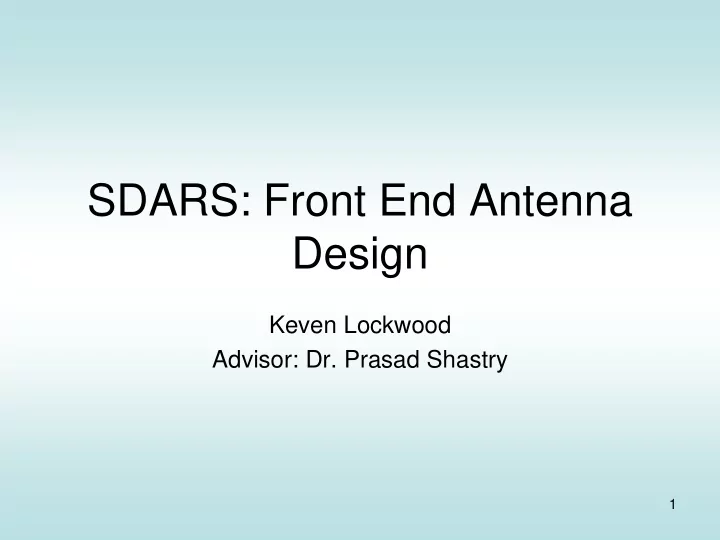

SDARS: Front End Antenna Design Keven Lockwood Advisor: Dr. Prasad Shastry 1
Outline • Project Overview • Antenna Characteristics • Feeding Techniques • Performance Specifications • Design Process • Expected results • Design Dependencies • Equipment • Schedule 2
Project Overview • Patch Antenna for receiving SDARS – Compact size • Idea from “A Circularly Polarized Microstrip Antenna using Singly-Fed Proximity Coupled Feed” by Iwasaki, Sawada, Kawabata – Not previously designed at BU • Past Projects – Greg Zomchek and Erik Zeliasz • Probe feed antenna • Aperture coupled feed antenna – Sasidhar Vajha • Proximity coupled, linearly polarized, 1.9 GHz patch antenna Source: H. Iwasaki, H. Sawada, K. Kawabata. “A Circularly Polarized Microstrip Antenna Using Singly- Fed Proximity Coupled Feed.” Institute of Electronics, Information and Communication Engineers. September 3 1992. pp. 797-800.
Circular Polarization Above: Illustration of a right-hand circularly polarized wave. Right: Circularly polarized waves travelling in the +Z direction (out of page). Source (both figures): Ulaby, Fawwaz T. Fundamentals of Applied Electromagnetics. Pearson Education, Inc. 2007. p. 298 4
System Block Diagram Active Antenna Low-Noise Sirius Radio Antenna Amplifier Receiver Intermediate frequency ready for Mixer Band pass filter IF amplifier decoding Down Converter Local Oscillator 5
Antenna Characteristics • Gain • VSWR, input impedance • Polarization • 3-dB beamwidth • Axial Ratio Representative plots of the normalized radiation pattern of a microwave antenna in (a) polar form and (b) rectangular form. Source: Ulaby, Fawwaz T. Fundamentals of Applied Electromagnetics. Pearson Education, Inc. 2007. p. 382 6
Feeding Mechanism Source: Balanis, Constantine A. Antenna Theory: Analysis and Design. 2 nd ed. John Wiley & Sons, Inc. 1997. p. 725. 7
Feeding Mechanism: Microstrip • Simple to fabricate / model • Simple to match with inset position • Prone to spurious feed radiation, limiting bandwidth Source: Balanis, Constantine A. Antenna Theory: Analysis and Design. 2 nd ed. John Wiley & Sons, Inc. 1997. p. 725. 8
Feeding Mechanism: Coaxial • Easy to fabricate, difficult to model • Narrow bandwidth • Low spurious radiation Source: Balanis, Constantine A. Antenna Theory: Analysis and Design. 2 nd ed. John Wiley & Sons, Inc. 1997. p. 725. 9
Feed: Aperture Coupled • Independent optimization of patch and feed • Difficult to fabricate • Narrow bandwidth • Easier to model Source: Balanis, Constantine A. Antenna Theory: Analysis and Design. 2 nd ed. John Wiley & Sons, Inc. 1997. p. 10 725.
Feed: Proximity Coupled • Wide bandwidth • Easy to model • Low spurious radiation Source: Balanis, Constantine A. Antenna Theory: Analysis and Design. 2 nd ed. John Wiley & Sons, Inc. 1997. p. 11 725.
Performance Specifications • 2320 MHz to 2332.5 MHz (BW = 12.5 MHz) – 100 channels, 125 kHz per channel • VSWR max = 2:1 • Left-hand circular polarization • Total active gain 28.5 dB - 32.5 dB 12
Antenna Design Process Paper Design Simulation Optimization Physical Testing Fabrication 13
Paper Design • Substrate selection – Thick, with low dielectric constant for better radiation efficiency, larger bandwidth (top layer) – Same dielectric constant, thin bottom layer • Patch Dimensions – Influenced by • Operating frequency • Collective height and dielectric constants of the substrates • Transmission line model equations • Feed line dimensions – Calculated using “MSTRIP” with Zo = 50 Ohms, dielectric constant, height of bottom substrate 14
Design Dependencies • ɛ r eff depends on h, t, and ɛ r of each • W p and L eff are inversely proportional to f r and the ɛ r eff • L eff = L + 2*(∆L) • ∆L is proportional to h+t • W s depends on h and ɛ r of bottom layer Source: Balanis, Constantine A. Antenna Theory: Analysis and Design. 2 nd 15 ed. John Wiley & Sons, Inc. 1997. p. 729.
Simulations • Momentum – Uses Maxwell’s equations – Measures and graphs • S11 (reflection coefficient) • VSWR, • input impedance • Radiation pattern – Optimization through variable sweeps 16
Fabrication • Create a template using final simulation dimensions (out-source) • Use template and substrate boards to fabricate individual layers • Carefully glue layers together • Solder on the packaged LNA and add SMA port (include picture of where LNA sits / what final product looks like 17
Physical Testing • Network analyzer – Graphs S11,VSWR, return loss – Gain of LNA, Noise Figure • Anechoic chamber – Beam pattern – Gain 18
Expected Results: VSWR Simulated VSWR of a linearly polarized patch antenna. VSWR measures the degree of input impedance match to 50 Ohms Image taken from: Erik Zeliasz, Greg Zomcheck. “SDARS Front -End Receiver: Senior Capstone Project Report.” Bradley University Department of Electrical Engineering, May 13, 2001. p. 19
Expected Results: S11 • Measures return loss at a center frequency of 1.9 GHz Graph taken from source: Vajha, Sashidar. “A Proximity Coupled Active Integrated Antenna.” Bradley University, 2000. 20 p.26
Expected Results: Input Impedance • No matching circuitry Graph taken from source: Vajha, Sashidar. “A Proximity Coupled 21 Active Integrated Antenna.” Bradley University, 2000. p.26
Equipment • Anechoic Chamber • HP 8722C Network Analyzer • RF fabrication machines • CAD with Momentum • Spectrum Analyzer 22
Schedule 1/23 – 1/27 – 2/3 – 2/10 – 2/17 – 2/24 – 3/2 – 3/9 – 3/16 – 3/23 – 3/30 – 4/6 – 4/13 – 4/20 – 4/27 – 1/26 2/2 2/9 2/16 2/23 3/1 3/8 3/15 3/22 3/29 4/5 4/12 4/19 4/26 5/3 Design Simulation/optimization (linearly polarized antenna) Simulation/optimization (circularly polarized antenna) Fabricate Antenna and testing Fabricate LNA board and testing Incorporate both the antenna and LNA and test integrate with commercial receiver and test Presentation and Final Project Report 23
Questions 24
Recommend
More recommend